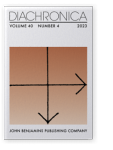Vol. 40:4 (2023) ► pp.532–556
Word order evolves at similar rates in main and subordinate clauses
Corpus-based evidence from Indo-European
In syntactic change, it remains an open issue whether word orders are more conservative or innovative in subordinate clauses compared with main clauses. Using 47 dependency-annotated corpora and Bayesian phylogenetic inference, we explore the evolution of S/V, V/O, and S/O orders across main and subordinate clauses in Indo-European. Our results reveal similar rates of change across clause types, with no evidence for any inherent conservatism of subordinate or main clauses. Our models also support evolutionary biases towards SV, VO, and SO orders, consistent with theories of dependency length minimization that favor verb-medial orders and with theories of a subject preference that favor SO orders. Finally, our results show that while the word order in the proto-language cannot be estimated with any reasonable degree of certainty, the early history of the family was dominated by a moderate preference for SVO orders, with substantial uncertainty between VO and OV orders in both main and subordinate clauses.
Article outline
- 1.Introduction
- 2.Data and Methods
- 2.1Data
- 2.2Methods
- 3.Results
- 4.Discussion and conclusions
- Supplementary materials
- Acknowledgments
- Note
-
References
